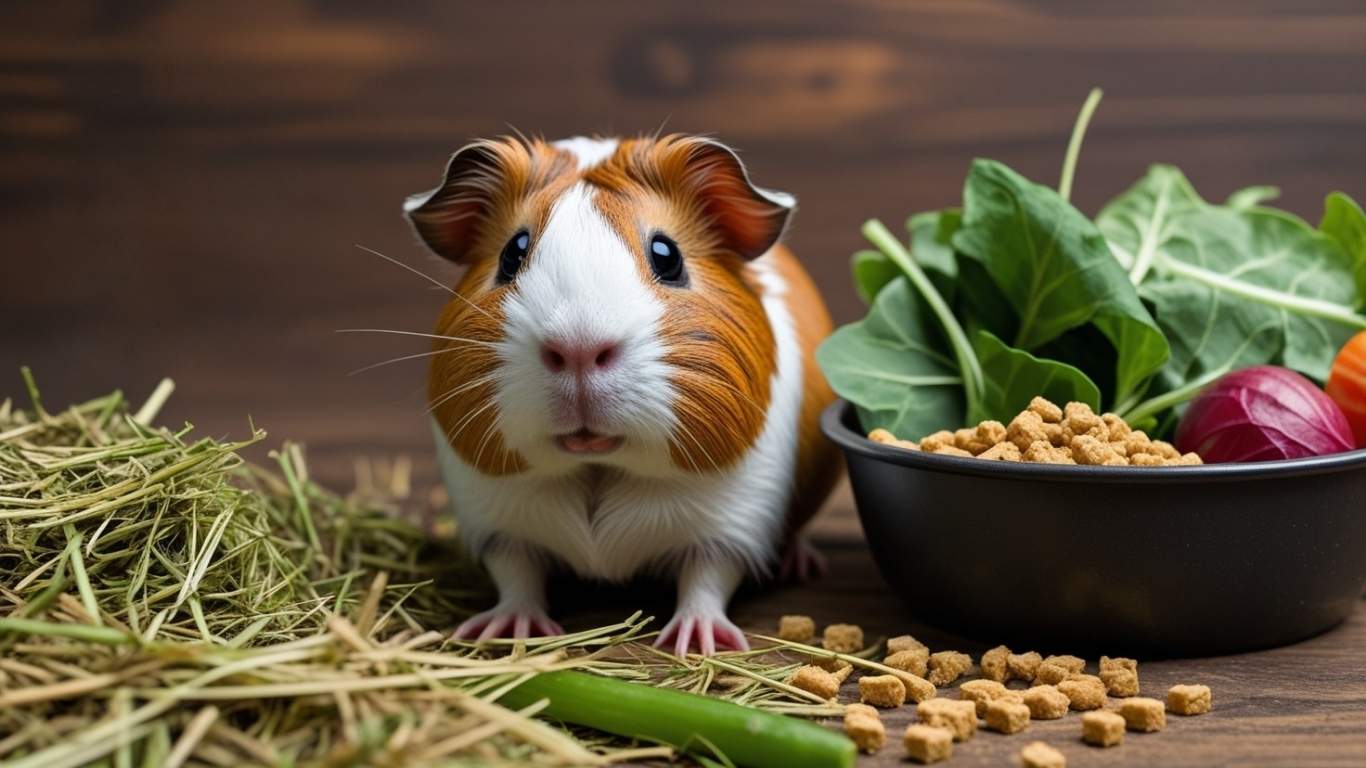Guinea pigs need unlimited access to high-quality hay for healthy digestion, dental care, and mental stimulation. Hay should make up 80% of their diet, providing essential fiber to prevent overgrown teeth and digestive issues. Choosing fresh Timothy or Orchard Grass hay and storing it properly ensures maximum benefits. A well-balanced diet with fresh veggies, hydration, and engaging hay-feeding methods keeps your guinea pig happy, active, and thriving!
The Essential Guide to Feeding Hay to Guinea Pigs
For guinea pig owners, understanding the importance of hay in their pet’s diet is crucial. Hay is the foundation of a guinea pig’s nutrition and plays a significant role in their overall health and well-being. While it may not seem as exciting as fresh vegetables or treats, hay is essential for their digestive health and dental care.
Guinea pigs are natural herbivores that consume various plant materials in the wild. As pets, their dietary needs remain the same. Providing unlimited access to fresh, high-quality hay ensures they can eat as much as they need without restriction. But how much hay do guinea pigs actually need, and why is it so vital?
How Much Hay Should Guinea Pigs Eat Daily?
Hay plays a critical role in the health of guinea pigs. It helps maintain healthy teeth and ensures proper digestive system function. The answer is simple regarding how much hay a guinea pig should eat: they need an unlimited supply. Guinea pigs should have the freedom to eat as much hay as they need throughout the day. On average, a guinea pig should have access to at least a bundle of hay about their size each day.
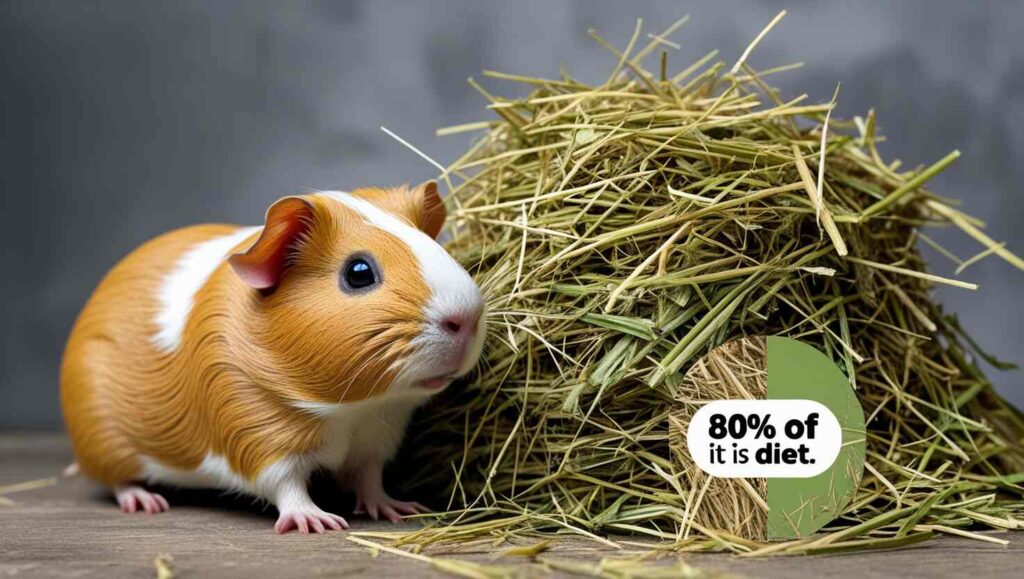
The Ideal Daily Hay Intake
Guinea pigs require an unlimited supply of hay to maintain their health. Veterinarians recommend that at least 80% of their diet consists of hay, as it provides essential fiber and helps prevent various health issues. The general rule is that a guinea pig should consume a body-sized amount of hay every day. While this may seem excessive, guinea pigs are natural grazers and will regulate their own intake based on their needs.
If you’re ever unsure about which foods are safe for your guinea pig, you can use simple tools like “Can Guinea Pigs Eat?” guides to check individual food types. Leafy green vegetables are great for guinea pigs, while fruits can be a nice vitamin-rich treat in small amounts. Just be careful to avoid foods meant for human consumption as their digestive systems aren’t designed to process them, which could lead to health issues.
Hay Consumption by Age and Size
The amount of hay a guinea pig eats varies depending on their size, age, and activity level:
- Adult guinea pigs typically consume 6-8 pounds (3-4 kg) of hay per month, ensuring they receive the fiber necessary for their digestive system.
- Younger guinea pigs may eat slightly less, around 5-6 pounds (2-3 kg) per month, as their smaller size requires slightly lower intake.
- Senior guinea pigs may need adjustments in their diet, including additional hay to maintain weight and digestive health.
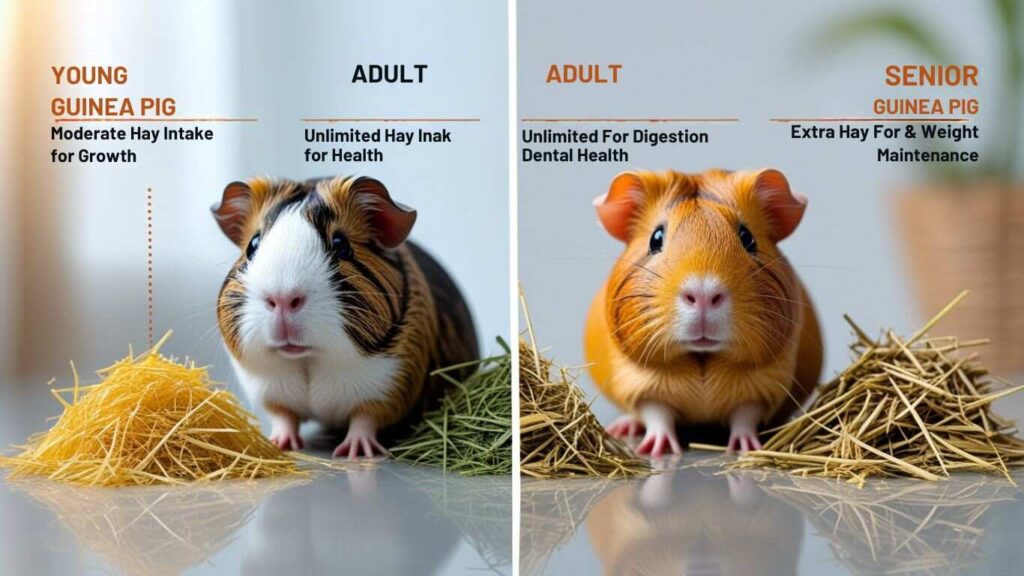
Since hay is low in calories and high in fiber, there is no risk of overfeeding. It is important to always provide fresh hay and remove any old or soiled hay from their enclosure.
Using Hay for Bedding
Many owners also use hay as bedding due to its softness and natural scent. While this can be beneficial, guinea pigs should not consume soiled hay, as it may lead to infections or digestive issues. A good alternative for bedding is Tiny Friends Farm Eco Bedding, which is non-edible and environmentally friendly.
Why Guinea Pigs Need Unlimited Hay
The short answer is that you really can’t put too much hay in a guinea pig’s habitat. Guinea pigs can’t eat too much hay; the more hay available, the better it is for them. Having a constant supply of hay allows your pet to forage and graze, which is not only vital for their physical health but also provides essential mental stimulation. At the end of the day, the more hay you can reasonably offer, the better for your guinea pig’s well-being.
Dental Health: Preventing Overgrown Teeth
Guinea pigs’ teeth grow continuously throughout their lives, and chewing hay is essential to keep their teeth at a healthy length. If a guinea pig does not receive enough hay, their teeth may become overgrown, leading to pain, difficulty eating, and severe dental issues. Overgrown teeth can also cause abscesses, infections, and weight loss due to an inability to chew properly.
Providing unlimited hay allows guinea pigs to wear down their teeth naturally, reducing the need for veterinary intervention. This makes hay an essential part of their daily dental maintenance.
Digestive Health: Ensuring Proper Function
Guinea pigs have a highly sensitive digestive system that relies on a constant intake of fiber. Hay promotes proper digestion by keeping the gastrointestinal tract moving efficiently. Without enough fiber, guinea pigs may suffer from conditions such as:
- Gastrointestinal stasis, a dangerous condition where food stops moving through the digestive system, leading to bloating and pain.
- Constipation, which can cause discomfort and other health complications.
- Diarrhea, which can occur if their diet is not balanced with enough fiber.
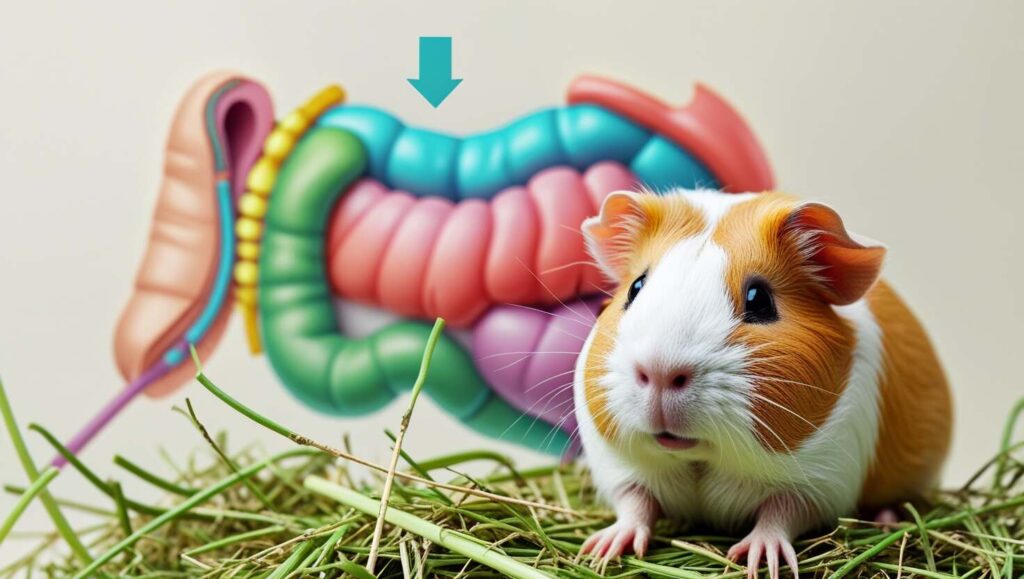
Providing unlimited hay ensures their digestive system functions smoothly, keeping their gut healthy and preventing serious medical conditions.
Alfalfa vs. Grass Hay: What’s Best?
Alfalfa Hay: When to Use It
It’s important to understand the difference between alfalfa and grass hays like Timothy when you offer them to your guinea pig. Alfalfa, being a legume and a member of the sweet pea family, contains more protein and more calcium than grass hays. This makes alfalfa ideal for pets with higher energy needs, such as the young, growing, pregnant, or nursing pets. However, for healthy adult animals, alfalfa should only be offered as a treat. For healthy adults, alfalfa should only be given as an occasional treat, as excessive calcium can lead to bladder stones and kidney issues.
Alfalfa hay is a legume hay that contains higher protein and calcium levels than grass hay. It is suitable for:
- Young, growing guinea pigs that need extra nutrients for development.
- Pregnant or nursing guinea pigs that require additional energy and calcium.
- Senior guinea pigs struggling to maintain a healthy weight.
For senior pets, alfalfa can benefit those that need help to maintain a healthy weight, especially if they are struggling to keep weight on. However, it’s crucial to consult with an exotic veterinarian to weigh the pros and cons before offering it more regularly. The best practice is to ensure your guinea pig has ample amounts of high-quality, high-fiber grass hay in their habitat, as this is key to keeping them on a proper nutritional path.
The Best Hay Types for Guinea Pigs
Timothy Hay: The Gold Standard
Timothy hay is widely regarded as the best type of hay for guinea pigs because it is high in fiber, low in protein, and low in calcium, making it perfect for maintaining dental and digestive health. It is available in different cuts:
- First-cut Timothy hay – Coarse and fibrous, great for wearing down teeth.
- Second-cut Timothy hay – Softer and more palatable while still providing fiber.
- Third-cut Timothy hay – Very soft but lower in fiber, ideal for picky eaters.
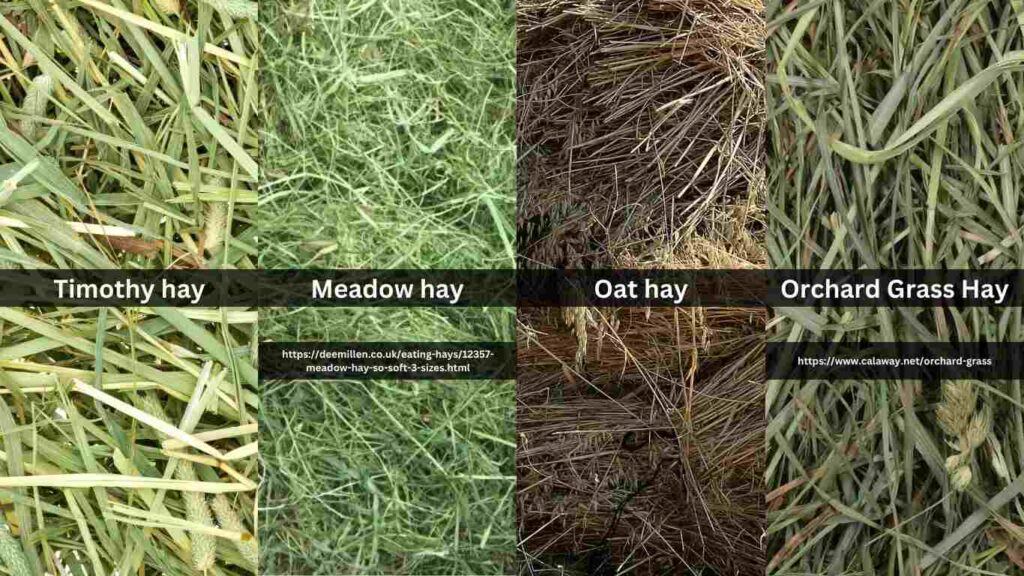
Other Hay Options
- Meadow Hay – Contains a variety of grasses and herbs, offering diversity in taste and texture.
- Oat Hay – Slightly sweeter but should be introduced gradually to avoid digestive upset.
- Orchard Grass Hay – A great alternative for guinea pigs sensitive to Timothy hay, as it is soft and fragrant.
Always offer hay in a hay rack or tray to keep it clean and encourage regular consumption.
How to Feed Hay to Guinea Pigs
Providing Constant Access
As guinea pig parents, it’s important to ensure your pets have constant access to hay. One effective way of feeding them is by placing large hay piles in multiple corners of their cage. This allows your guinea pigs to easily find the hay, encouraging them to explore and forage naturally. Spreading hay in different spots is particularly beneficial because it ensures they won’t run out quickly, and your guinea pigs can enjoy running around and discovering their favorite areas to nibble.
Managing Hay Mess and Dust
Guinea pigs need plenty of hay to eat, but simply leaving it in piles can create a mess. They may run through the hay, scattering it around the cage and causing dust buildup. This dust can be irritating for both you and your pets, especially if anyone is allergic to hay. It can also become airborne when removing hay from bags or when guinea pigs rummage through it, potentially affecting their respiratory health. To prevent respiratory infections, which can be serious, it’s important to monitor dust levels in their cage and keep it clean by vacuuming regularly.
Hay can be messy, and dust from low-quality hay may cause respiratory issues. To minimize dust:
- Choose high-quality, dust-extracted hay.
- Use hay racks or containers to keep hay clean and organized.
- Consider GuineaDad Hay Boxes or Hay Bars, which are micro-filtered and free from contaminants.
Making Hay Feeding Fun
Guinea pigs enjoy foraging, so incorporating hay enrichment activities can improve their mental stimulation:
- Hay balls or stuffed tubes encourage foraging and exercise, helping them stay healthy and active.
- Edible hay packaging can double as a chew toy, aiding in dental health.
Guinea pigs like Ru and Mi love to climb into their hay boxes when the hay runs low and use them as little hideouts, which adds another layer of fun and comfort to their environment.
Best Ways to Store Hay for Freshness
To keep hay fresh and nutritious for your guinea pig, it’s important to store hay properly. Always make sure to keep it dry to prevent it from spoiling quickly. Avoid storing hay in damp places like a basement or garage where it might come into contact with water. Using an airtight container such as plastic bins with tight-fitting lids will help protect the hay from moisture and pests.
To keep hay fresh and nutritious:
- Store it in a cool, dry place to prevent mold growth.
- Using airtight containers such as plastic bins with tight-fitting lids will help protect the hay from moisture and pests.
- Avoid exposure to direct sunlight, which can dry out essential nutrients.
- Rotate hay supplies frequently to maintain quality and freshness.
If you have a large quantity of hay, divide it into smaller portions and use them within weeks to ensure you’re always offering the freshest hay. While hay can last for several months if stored properly, it’s ideal to rotate through the portions to avoid spoilage. Keeping your guinea pigs’ hay levels well stocked means you’ll have no issue working through a large bag.
Avoiding Odor Contamination
Hay can absorb odors from cleaning supplies or perfumes, affecting its palatability. Always store hay in a well-ventilated, odor-free environment to preserve its natural scent and taste.
The Key to a Balanced Guinea Pig Diet
Hay is the most essential part of a guinea pig’s diet, making up 80% of their food intake, and it’s incredibly important to provide the right amount to keep your pet healthy. Feeding hay regularly ensures that your guinea pig gets the proper nutrition they need for healthy digestion and teeth. The healthiest way to feed hay is by giving them constant access to it. Taking care to provide safe and clean hay is one of the best efforts you can make to help extend their lifespan and keep them in good condition.
Providing unlimited access to high-quality hay ensures:
- Healthy teeth through natural chewing,
- Proper digestion with sufficient fiber.
- Mental stimulation through foraging behavior.
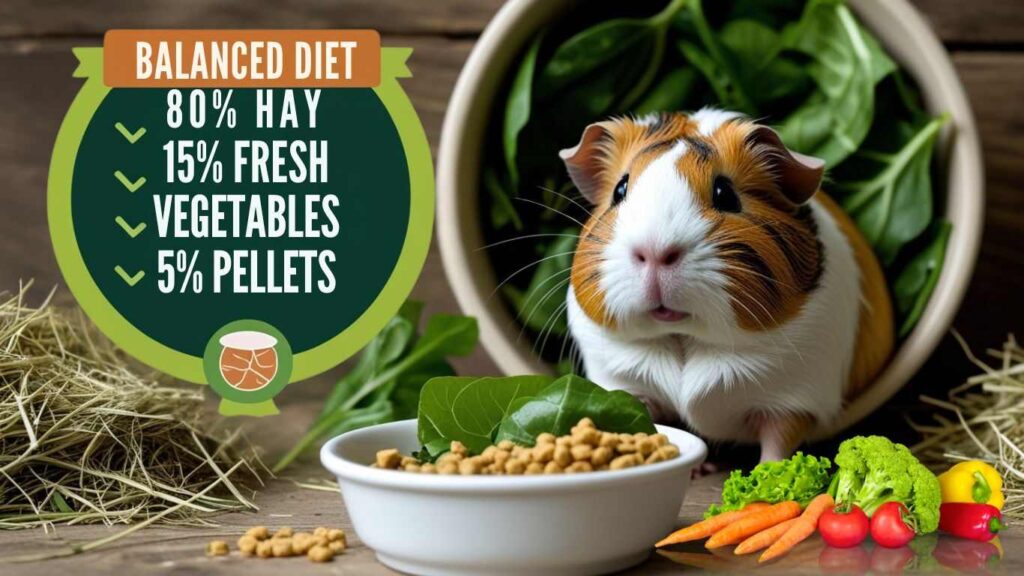
The remaining 20% of a guinea pig’s diet should include a balanced portion of fresh vegetables, especially leafy greens. Along with that, you need to feed a carefully measured amount of special guinea pig food designed to meet their nutritional requirements, including their need for vitamin C. Guinea pig diets can come in muesli-style mixes like Gerty Guinea Pig Tasty Mix or single-component diets like Gerty Guinea Pig Tasty Nuggets or Science Selective Guinea Pig. If you want to learn more about different types of food for small pets, you can explore various resources or blogs on this topic.
Conclusion
Providing unlimited, high-quality hay is the foundation of a healthy guinea pig diet, ensuring proper digestion, dental care, and mental stimulation. As natural grazers, guinea pigs rely on fiber-rich hay to prevent overgrown teeth, gastrointestinal issues, and boredom. Choosing the right hay, such as Timothy hay or Orchard Grass, and storing it properly ensures freshness and nutritional value. While alfalfa hay may be beneficial for young, pregnant, or senior guinea pigs, it should be offered in moderation to avoid excess calcium intake. Incorporating hay in fun ways, like using hay racks, edible packaging, or foraging activities, enhances their well-being while keeping their environment clean and enriched. By maintaining a balanced diet with fresh vegetables, pellets, and proper hydration, guinea pigs can thrive, staying active, happy, and healthy. Ensuring constant access to fresh hay is one of the most effective ways to support your piggy’s overall health and longevity.
Kindly note: The content shared in this blog is gathered from online sources, some of which may not be verified. For accurate guidance on caring for your guinea pig, it is recommended to seek advice from a qualified veterinarian.

